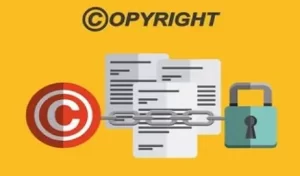A new era started with the innovation of Artificial Intelligence (AI). AI systems can produce…
Infringement of copyright and fair usage of IP Laws
Copyright infringement & fair use
The term ‘Intellectual’ implies that it is specific to the mind or talent. Thus, Intellectual property refers to the creation of the human mind. It is non-physical (intangible) and it derives its value from ideas. It is a legal concept that confers the right to owners and creators of the work, for their intellectual creativity. The intellectual property owner can control and be rewarded for its use.
[Image Sources : Shutterstock]

Rationale Behind IP Protection
Countries have laws to protect intellectual property for the following reasons-
- To provide statutory expression to the moral and financial rights of creators in their creations and the rights of the public regarding those creations.
- To promote creativity, as well as to disseminate and apply its results.
- To promote fair trade, which will contribute to economic and social development.
Copyright is the inherent right of a creator, artist, composer or another creator to prevent the use of their work. This means that a copyrighted work can not be copied or appropriated by others without the creator’s consent. Furthermore, the true inventor is in control of the work’s public display or performance.
As informed, a copyright is a right that takes effect with the creation of the work, with registration required only in cases of legal difficulties or enforcement of economic rights. In order to provide an essential balance between the copyright owners’ rights, certain exceptions known as ‘user rights, as codified by the 1976 Copyright Act, exist to this exclusive right. One of these exceptions is the Fair Use Doctrine.
What is fair use in terms of copyright?
Fair use comes with an affirmative defence that can be used in reply to claims by the sole owner of a copyright that a person is infringing a copyright. Fair use grants any third party to use a copyrighted work without the copyright owner’s consent for intents such as teaching, reporting, research, news report, comment or scholarship. These purposes only represent what might be regarded as fair use and are not samples of what will consistently be framed under fair use. In fact, there are no bright-line regulations in deciding fair use, since it is determined on a case-to-case basis. But the law of copyright does establish four factors that must be considered in deciding whether a use constitutes fair use. These factors are
- The aim and purpose of the use, including if at all such use is of a retail/commercial nature or is for non-profit academic purposes;
- The characteristics/nature of the copyrighted work;
- The substantiality/amount of the substance used in relation to the copyrighted task as a whole; and
- The consequences of the usage upon the potential market for or significance of the copyrighted work.
It is important to consider each factor in determining whether a use falls within the fair use exception, even if one factor weighs more heavily than another. However, the first and fourth factors are usually the most influential.
How do you define Fair Dealing?
Fair managing is allowed for private use including with the end goal of research or criticism or review[1]. Such a ‘fair managing’ arrangement likewise stretches out to imitate scholarly, emotional, melodic or imaginative work to report recent developments in a paper, magazine or comparative periodical or by broadcast[2] or in a cinematograph film or through photographs30 or utilizing selections of an exhibition or of transmission in the revealing of recent developments or for boa bonafide survey, educating or research. Further, it has been embedded through a revision in 1994, that the demonstration of making duplicates or transformation of a PC program by the legal owner for which it was provided or as a way to offer brief against misfortune, obliteration or harm of the program.
In the leading case of Urban Chandran v. Ammini Amma[3], the learned adjudicator noticed:
“The term ‘fair managing’ has not been characterized as such in the Demonstration. In any case, segment 52(1)(a) and (b) explicitly alludes to the ‘fair managing’ of the work and not to the proliferation of the work. As needs are, it could be sensible to hold that the re-creation of its entire or a significant piece as such won’t typically be allowed and just concentrates or citations from the work will alone be allowed even as fair managing.” That’s what further the court held “In such cases, the court needs to think about (1) the quantum and worth of the matter taken corresponding to the remarks or analysis; (2) the reason for which it is taken; and (3) the probability of contest between the two works”; it is like the four component trial of the U.S. fair use tenet.
Contrast Between Fair Managing and Fair Use
“Fair managing” and “fair use” are connected ideas relating to clients’ privileges under intellectual property regulation. It is in any case vital to comprehend that fair managing and fair use are not equivalent terms since their importance and degree are characterized by various general sets of laws. It is trying to briefly enough sum up the common and dissimilar underpinnings of fair management and fair use. The accompanying brief examination means to outline an expansive image of a portion of the essential similitudes and contrasts between fair managing and fair use only.
Fair managing is an exemption for copyright encroachment spread out in the copyright rules of customary regulation locales like Extraordinary England, Canada, Australia and New Zealand. The copyright demonstrations of these wards give that fair management of a protected work won’t add up to encroachment assuming such management is expressed in the demonstration. This implies, that in the event that a work is replicated for a reason other than the legal fair managing purposes, the duplicating can’t be a fair managing no matter what the copier’s aim.
Author : Isha, a student of Bharti Vidyapeeth University, New Law College, Pune, in case of any queries please contact/write back to us via email to [email protected] or at IIPRD.
[1] Ibid., S. 52(a)(ii)
[2] The word ‘broadcast’ has been subs. by Act 23 of 1983, S. 2, for “radiodiffusion” (w.e.f. 9-8-1984).
[3] 1996 PTC 670 (Ker HC) 675-677.



